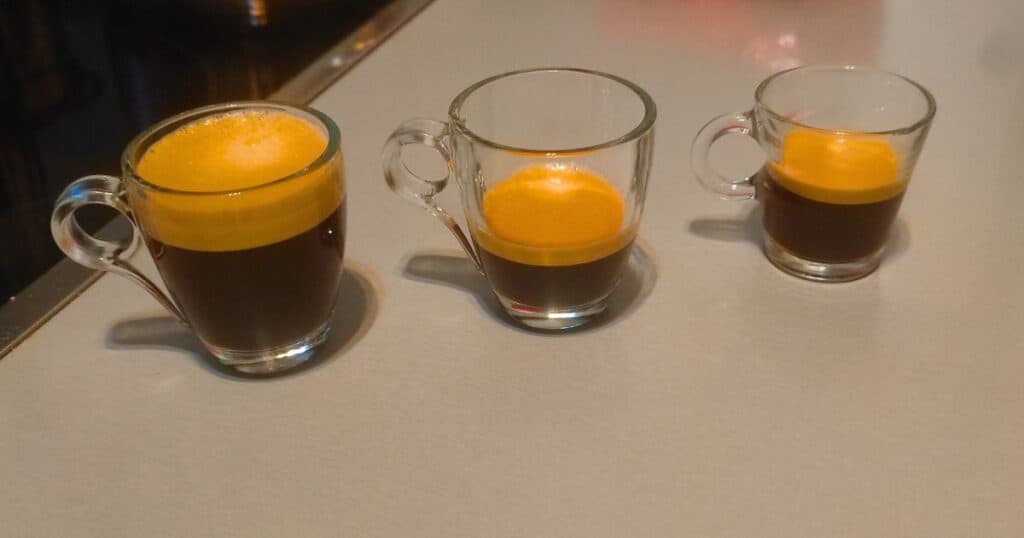Ever said to yourself ‘Why is my espresso foamy?’
Why does it really matter to know if your espresso is foamy? It’s happened to me too; you brew coffee and the top foamy layer is way too much. Stick around, in this article I chat about why this happens and I also give away tips for a perfect espresso.
Let’s jump straight into it.
Key takeaways:
- What makes an espresso foamy
- 4 different types of espresso foam
- Do fresh coffee beans produce more foam?
Why is my espresso foamy?
One of the main reasons your espresso is too foamy is the type of coffee beans you use. Other common reasons are the quality of the coffee beans, how much you tamped the coffee grounds and the amount of coffee grounds used.
What is espresso foam?
Espresso foam is also known as espresso crema and it’s the top layer of an espresso. You can achieve espresso foam when brewing with an espresso machine. But it’s fairly difficult (if not impossible) to achieve it with a Moka pot. Reason being coffee made with an espresso machine requires high pressure (about 9 bars) whereas espresso made with a Moka pot is made with way less than that.
Why does it matter?
Practically, the crema on an espresso doesn’t add extra flavour, but let’s be honest it makes it more pleasing to the eye; you can enjoy an espresso with a layer of crema.

How does espresso crema form?
Let’s go over the process of what’s happening when brewing coffee with an espresso machine.
Water is moved from the water tank to where the coffee grounds are and by using high pressure the water extracts the flavours and oils from the coffee grounds. Along with the actual coffee liquid, water is creating a thicker layer than coffee. When espresso starts to flow into your cup it gets back to a lower pressure than the one used in the brewing process and because it can’t maintain a high level of CO2 (which is released by the water) bubbles are created and form a cream layer on the top of your espresso.
5 different types of espresso foam
Let’s chat about 4 different types of espresso foam.
1. White with large bubbles
Why does your espresso have white bubbles?
What does that mean?
This is a sign that the coffee is over-extracted, meaning that you let the espresso machine brew your coffee too long. Because of these coffee flavours are left behind and as you might have guessed your coffee is going to be less tasteful or even more bitter than it should be. Using water that’s too hot causes this white crema layer also which typically leads to over-extraction that still makes your coffee taste just not right. The temperature you need to aim for is between 195-205°F (90.5°C-96.1°C).
2. Pale foam
If the crema layer of your espresso is pale in colour, it typically means there was under-extraction during the brewing process, meaning your coffee machine brewed the coffee for shorter than it should be (20-30 seconds).
The taste of this coffee?
It’s going to be weak as a lot of flavours and aromas are left behind and as a result, it won’t be the most enjoyable coffee you’ll ever have.
Also, another reason that you get pale foam colour for your espresso is that your coffee grounds are too finely grounded so the water finds almost no resistance when runs through, so the coffee is brewed faster.
3. Dark foam with a white line in between
This happens when your coffee grounds are too finely grounded. It’s good to grind your coffee grounds finely enough but it’s wise not to go over the top. Otherwise, you end up with this weird line in your coffee.
4. White foam in the middle of the crema
‘Why is there white foam in the middle of the cup?’, you might be wondering. This most of the time happens because you might have brewed your espresso for too long. Try your best to brew your coffee between 20-30 seconds to avoid any marks in your coffee.
5. Different colour in the crema
You might have noticed that the colour of the crema you make at home is different to the colour of the crema the one in a coffee shop. This isn’t necessarily something to worry about as the colour of the crema changes based on the coffee beans you use for brewing. If they are dark the crema is going to be darker while when you use light roasts for brewing, they produce lighter colour.
Τhis table summarises the 4 different espresso foams:
| Foam: | Meaning: |
| White with large bubbles | Over extraction |
| Pale foam | Under extraction |
| Dark foam with a white line in between | Too thin coffee grounds |
| White foam in the middle of the crema | Over extraction |
| Different colour in the crema | It depends on the coffee beans you use |
Which coffee beans produce more foam?
It’s not necessarily a bad thing to brew coffee with a lot of foam.
As mentioned earlier, it heavily depends on the beans you use for brewing. Another factor that makes a lot of crema is the freshness of your coffee grounds. By this I mean, when you grind your coffee beans right before brewing the crema layer is going to be richer than using pre-ground coffee beans.
So, it’s entirely up to you whether you like an espresso with rich or less rich foam.

Does coffee freshness impact the crema in your espresso?
This is a great way to see how fresh your coffee grounds are, especially if you use pre-ground coffee.
For example, if your layer is very thin, the odds are that your coffee grounds aren’t freshly grounded while when you achieve a rich crema this typically means the package you bought with pre-ground coffee beans is freshly ground.
It’s always better to use freshly grounded coffee grounds as your espresso is going to have a rich aroma and taste so much better.
An avid espresso consumer shares their opinion on what causes too much foam in espresso:
I’m sure there are many reasons, but in my case I find that the foam allows me to drink very hot coffee that cools to drinking temperature as it passes through the foam. Additionally, it seems to take the bitter edge off of even unsweetened espresso, and gives a richer mouthfeel to the drink even when using skim milk.
– H. S. Levine
Let’s wrap it up
Still, wondering ‘Why is my espresso foamy’? As discussed in this article there are certain things that make your espresso foamy. Making espresso is more of a science than an art, meaning that if you stick to the fundamentals you’ll be able to brew great espresso.
FAQ
Let’s go over a couple of questions that often come up when it comes to espresso and crema.
Should a proper espresso have crema on top?
It really depends. If you brew espresso with a Moka pot then you won’t get a lot of foam whereas when you brew with an espresso machine you’re going to get a proper layer of foam. Reason being, when brewing with an espresso machine the pressure of brewing is way higher compared to the Moka pot (9 bars vs 1.5 bars).
What does cream taste like?
It’s arguably not the tastiest thing. It’s typically more bitter than the actual espresso itself and it’s thicker than espresso. But it’s nice to have this layer in your coffee as it makes it more appealing and obviously an espresso with crema looks better than one without.
Should you stir or skim the crema?
It’s entirely up to you whether you want your coffee more bitter. If you do just stir it or leave it as it is. But if you don’t like your coffee to be too bitter you can always skim it and enjoy your espresso without much crema. Either way, an espresso is always a great way to treat yourself.
How much crema should my espresso have?
A great rule of thumb is to brew espresso with crema that is 1/10th of your cup. This way your espresso isn’t going to be too bitter and at the same time is going to look pleasing to the eye which definitely adds to the experience of drinking coffee.
What should the perfect crema look like?
It should be a solid layer with a lighter colour than the espresso itself. If it has a hole in the middle it means that you didn’t manage to make enough crema for your espresso and tbh it won’t look as appealing as it would have a solid crema layer.
How to get more foam in espresso?
The best way is to use freshly ground coffee beans. This way it increases the foam layer and of course, it makes your coffee richer in flavour and aroma.

- How to Remove Coffee Stains From Countertop The Easy Way - December 21, 2023
- Can You Reuse Coffee Grounds in French Press? Truth Inside - December 12, 2023
- Can Expired Coffee Creamer Make You Sick? 3 Ways to Find Out - December 9, 2023
